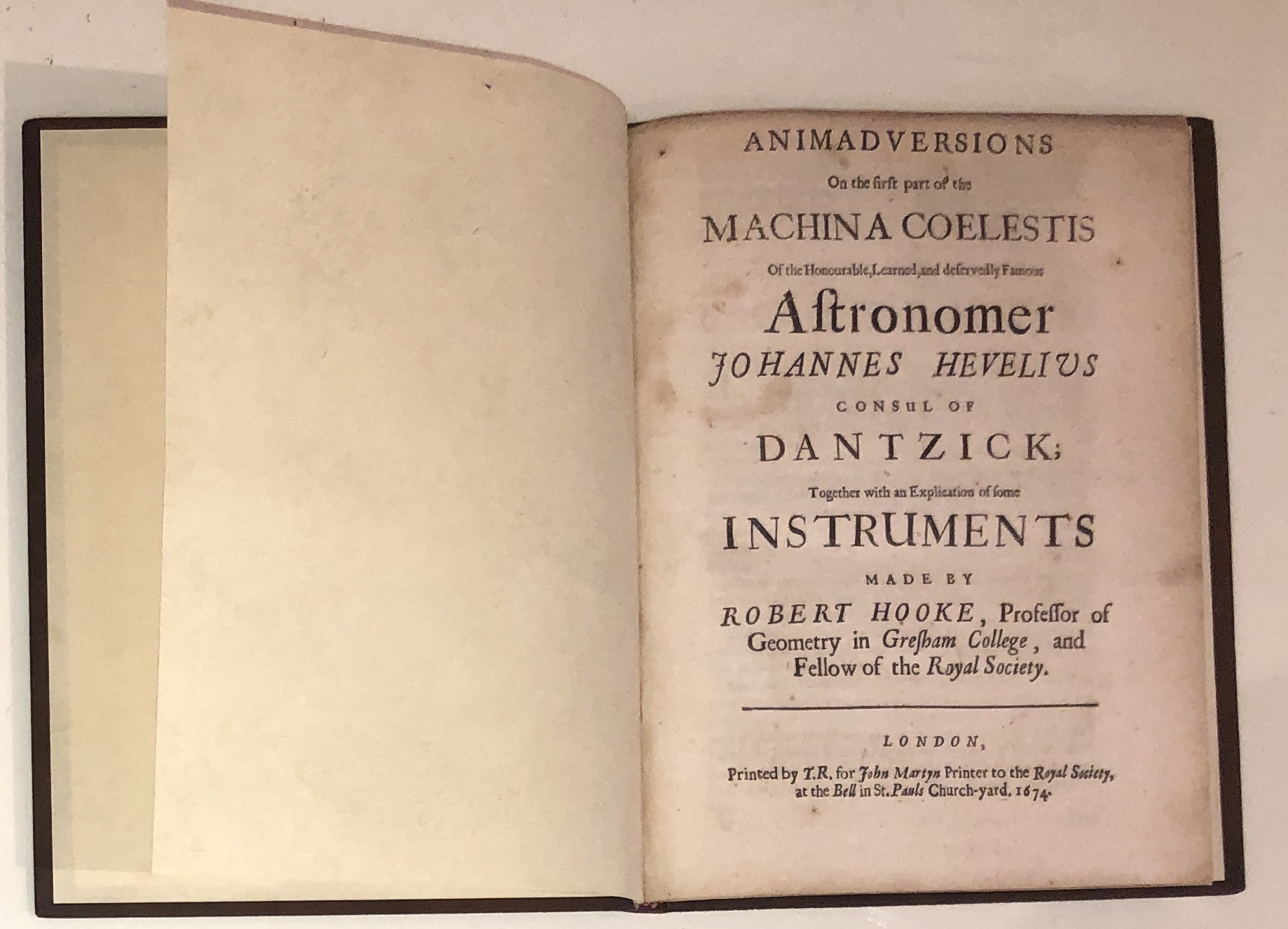Robert Hooke’s principal work on astronomical instruments, 1674, including the clock-driven telescope and universal joint
£6,500
Hooke's 'Animadversions on the first part of the Machina Coelestis ... together with an explication of some instruments made by Robert Hooke', 1674. Including Hooke's invention of the clock-driven telescope and the universal joint
Dimensions
212 x 158mm
Circa
1674
Country of manufacture
UK and Ireland
Description
Animadversions on the first part of the Machina Coelestis of the honourable, learned, and deservedly famous astronomer Johannes Hevelius Consul of Dantzick; together with an explication of some instruments made by Robert Hooke, Professor of Geometry in Gresham College, and Fellow of the Royal Society, 1674.
4to, pp. [viii], 78 with three folding engraved plates.
First edition, very rare, of Hooke’s most confident and outspoken treatise on instrumentation, Animadversions, which derived from a lecture delivered at Gresham College on 11 December 1673 and was published the following year. “Animadversions started with a sustained and convincing exposure of the inadequacy of Hevelius’s astronomical instruments. Hooke pointed out that on the arc of a brass quadrant or sextant with a six-foot radius, a minute measured only a fiftieth of an inch, and a second a three-thousandth of an inch, which no man living could distinguish with his naked eye … Plainly, he argued, instruments could not be more accurate than their least accurate component, and all the care that Hevelius had devoted to marking the divisions on his instruments, refining his plumb lines, improving his sights and increasing the scale and rigidity of his quadrants counted for little, ‘since the power of distinguishing by the naked eye is that which bounds and limits all the other niceness [precision]’. In short, Hevelius’s instruments were no more accurate than those used by Tycho Brahe almost a hundred years earlier, and all his achievements were undermined by his use of plain sights. Nothing that Hevelius had written could explain his strange resistance to telescopic sights, whose value Hooke had painstakingly explained to him in the 1660s” (Inwood, The Man Who Knew Too Much (2002), p. 180).
As if to emphasize how outdated Hevelius’ instruments were, Hooke here describes one of his most remarkable inventions, his equatorial quadrant. “Hooke brilliantly exploited the unrivalled breadth of his mechanical and scientific experience, his much-criticized versatility, to devise an instrument that none of his contemporaries could have produced, and which anticipated features that would not become standard for 150 years. His equatorial quadrant brought together his work on conical pendulums and clockwork, his knowledge of spirit levels, his refinement of micrometer screws and eyepieces, his experience of telescopic sights and his invention of the reflecting quadrant, and combined these with two new and valuable mechanical devices for the transmission of rotary motion, the universal joint (or ‘Hooke Joint’) and the worm-wheel … He described a large iron quadrant, with a radius of about five feet, in which accuracy was achieved not only by telescopic sights and cross-thread micrometer eyepieces but by the clever use of a screw adjustment on the movable limb of the quadrant. Hooke had first described this perpetual screw device, which is still used in marine sextants, in a Royal Society meeting in March 1666. It could be used as a dividing engine, to mark the divisions of a quadrant with much greater precision than existing geometrical techniques. In explaining how a circle could be divided mechanically, using gearwheels instead of geometry and approximation, Hooke anticipated Jesse Ramsden’s work on dividing engines and other machine tools in the 1770s” (Inwood, pp. 182-4). The universal joint found numerous later applications, including by Henry Ford in the drive shafts of automobiles.
Rare Book Hub lists only one copy in the last 45 years, which realised £5,002 at Bloomsbury in 2013.
A very good copy bound in panelled calf in the style of the period. Text lightly browned with a few early marginal annotations (ink smudge to lower blank margin of one page).













